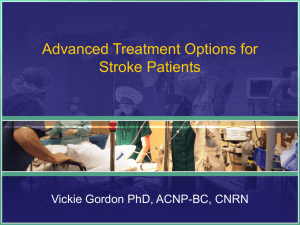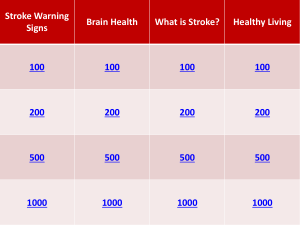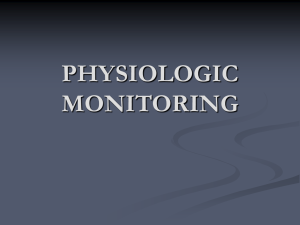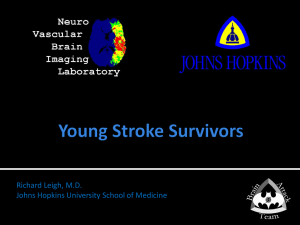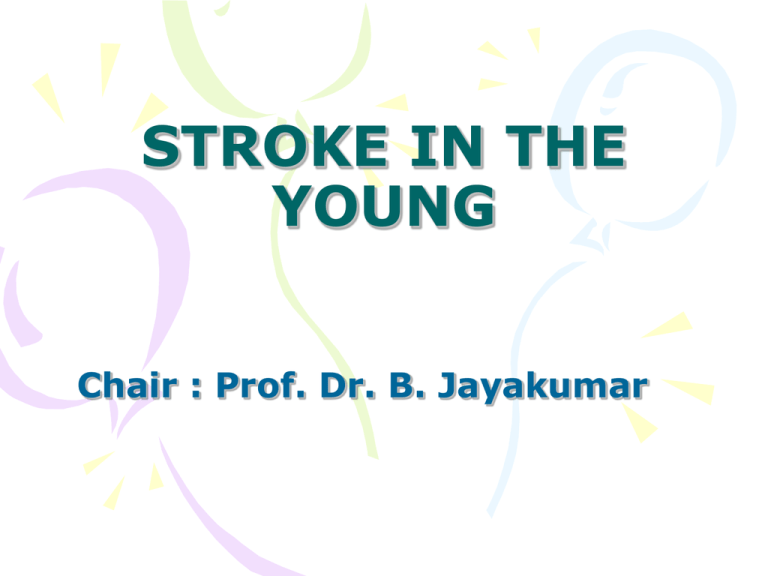
STROKE IN THE
YOUNG
Chair : Prof. Dr. B. Jayakumar
INTRODUCTION
• Young stroke is stroke occurring
between 15 and 45 years of age
• Differential diagnosis for potential
etiologies is broader
• Even after extensive investigations,
the cause may remain elusive in 2050% cases
• Prognosis depends on the underlying
factor
• Responsible for about 5% of all cases
of stroke
• Incidence is much higher in
developing countries like India.
• Above the age of 30 years stroke is
more common in males whereas
below that female predominance is
seen.
Etiology of young stroke
ISCHEMIC
• Large artery disease
– Premature atherosclerosis
– Dissection (spontaneous or traumatic)
– Inherited metabolic diseases (homocysteinuria,
Fabry’s disease, pseudoxanthoma elasticum,
MELAS syndrome)
– Fibromuscular dysplasia
– Vasculitis
– Moyamoya disease
– Radiation
– Toxic (drug induced)
• Small vessel disease
– Vasculopathy (infectious, non infectious,
microangiopathy)
• Cardioembolic disease
–
–
–
–
–
–
–
–
Rheumatic heart disease
Congenital heart disease
Arrhythmias
Bacterial and non-bacterial endocarditis
Mitral valve prolapse
Patent foramen ovale
Atrial myxoma
Cardiac surgeries and procedures
• Hematologic disease
– Sickle cell disease
– Leukemia
– Hypercoagulable states (antiphospholipid
antibody syndromes, deficiency of
antithrombin III or protein S or C, resistance
to activated protein C, increased factor VIII)
– Disseminated intravascular coagulation
– Thrombocytosis
– Polycythemia vera
– Thrombotic thrombocytopenic purpura
– Venous occlusion
• Migraine
• HEMORRHAGIC
• Subarachnoid hemorrhage
– Cerebral aneurysm
• Intraparenchymal hemorrhage
– Arteriovenous malformation
– Neoplasm (primary central nervous system,
metastatic, leukemia)
– Hematological disorders (sickle cell disease,
neoplasm, thrombocytopenia)
– Moyamoya disease
– Drug use (warfarin, amphetamines, cocaine,
phenylpropanolamine)
– Iatrogenic (peri-procedural)
Premature atherosclerosis
• Premature atherosclerosis is the
single most important cause of
stroke as age advances
• Incidence is 7-30% below the age of
50 years.
• It is presumed in all undiagnosed
cases with more than two risk
factors.
• Risk factors for atherosclerosis
– Male sex
– Systemic hypertension
– Diabetes mellitus
– Dyslipidemia (low HDL cholesterol,
hypertriglyceridemia)
– Cigarette smoking
– Alcohol abuse
– Ischemic heart disease
– Recent infection
– Oestrogen related stroke including oral
contraceptives
NON ATHEROSCLEROTIC
VASCULOPATHIES
• Cervicocephalic arterial dissections
• Traumatic cerebrovascular disease
• Radiation-induced vasculopathy
• Moyamoya disease
• Fibromuscular dysplasia
• Vasculitis
• Migrainous infarction
Cerviocephalic arterial
dissections
• Subintimal penetration of blood with
subsequent longitudinal extension of
the hematoma between its layers
• Common sites
– Extracranial segment of internal carotid
artery
– Extracranial vertebral arteries
• Recurrence rate is 1%, more in
young and in those with positive
family history
Causes
• Spontaneous
• Secondary
–
–
–
–
–
–
–
–
–
–
–
–
–
Blunt or penetrating trauma
Fibromuscualar dysplasia
Ehlers’ Danlos syndrome type IV
Marfan’s syndrome
Pseudoxanthoma elasticum
Coarctation of aorta
Menke’s disease
α1-antitrypsin deficiency
Cystic medial degeneration
Osteogenesis imperfecta
Adult polycystic kidney disease
Homocystinuria
Luteic arteritis
• Dissection results in ischemic
symptoms due to arterial occlusion
or secondary embolism
• Diagnosis
– Arteriography – Elongated, irregular,
narrow column of dye, ‘string sign’
– High resolution MRI
– MR angiography
– CT angiography
– Doppler ultrasound of the neck
especially for carotid diseection
Internal
carotid artery
dissection
• Treatment
– Anticoagulation with heparin should be
started followed by warfarin therapy for
3–6 months
– Antiplatelet therapy
– Surgical therapy indicated in the
presence of pseudoaneurysms and if
there is no response to medical
treatment
– Anticoagulation should be withheld in
intracranial dissection since there is a
risk of subarachnoid haemorrhage
Trauma
• Blunt or penetrating trauma can produce
arterial dissection, rupture, thrombosis,
pseudoaneurysm formation and AV fistula.
• Can occur during sports, violent coughing,
vigorous nose blowing, neck manipulation,
anesthesia administration etc.
• Cervical rotation or extension compresses
cervical carotid artery against transverse
processes of upper cervical vertebra
• Angiography and surgical repair is the
treatment.
Radiation vasculopathy
• Accelerated atherosclerosis occurs
especially in those with dyslipidemia
• Radiation results in damage to the
endothelial cells producing
complications months to years later
• Lesions occur at unusual sites
• The amount of damage depends on
– Radiation dose
– Age at the time of therapy
Moyamoya disease
• Moyamoya is a Japanese word meaning
‘puff of smoke’
• It is a chronic progressive non-amyloid
non-atherosclerotic, non-inflammatory
occlusive arteriopathy of unknown cause.
• Characterized by progressive bilateral
stenosis of distal ICA extending to
proximal ACA and MCA with involvement
of circle of Willis and development of
extensive collateral network
(parenchymal, leptomeningeal or
transdural) at the base of the brain like a
puff of smoke. Intracranial aneurysms are
seen, especially in posterior circulation.
• Pathology
– Fibrocellular intimal thickening, smooth
muscle proliferation and increased
elastin accumulation leading to stenosis
of suprasellar intracranial ICA
– Thinning of media with tortuous and
multilayered internal elastic lamina
• Clinical features
– TIA, seizures, headache, movement
disorders, mental deterioration, cerebral
infarction , intracranial hemorrhage
– TIAs are precipitated by crying, blowing
and hyperventilation
• Bimodal age distribution is seen
– First decade – ischemic events more common
– Fourth decade – Hemorrhagic commoner
• Diagnosis is established by arteriography
• Suzuki’s six arteriographic changes
– Stenosis of carotid fork
– Initial appearance of moyamoya vessels at the
base of brain
– Intensification of moyamoya vessels
– Minimization of moyamoya vessels
– Reduction of moyamoya vessels
– Disappearance of the vessels
MCA block with multiple collateral
moyamoya vessels
Treatment
• Ischemic Moyamoya
– Platelet antiaggregants, vasodilators,
calcium channel blockers and
corticosteroids have been tried.
– Anticoagulants are not useful
– Surgical revascularization techniques
like superficial temporal to MCA
anastamosis have produced good
results.
• Hemorrhagic Moyamoya
– No established therapy to prevent
rebleed
Fibromuscualar dysplasia
• Segmental, non-atheromatous, dysplastic,
non-inflammatory angiopathy
• Commonly affects young and middle aged
women
• White race more affected
• Etiology
– Unknown
– May be related to immunological mechanisms,
estrogenic effects, α1-antitrypsin deficiency
– Familial association seen
• Renal arteries most commonly involved.
Cervicocephalic involvement in less than
1%
• Most often extracranial carotids involved
• Bilateral in two thirds
• Four histologic types
–
–
–
–
Intimal hyperplasia
Medial hyperplasia
Medial fibroplasia: Commonest
Perimedial dysplasia
• Most of the patients are asymptomatic
• Diagnosis
– Cervical angiography
– ‘String of beads’ appearance in medial
fibroplasia
• Treatment
– Benign natural history
– Platelet antiaggregants used
– Surgical intervention seldom needed
Types of fibromuscular dysplasia
Cerebral autosomal dominant
arteriopathy with subcortcal infarcts
and leucoencephalopathy (CADASIL)
• Familial nonarteriosclerotic, nonamyloid
microangiopathy
• Characteristic features
– Migraine with aura (CADASILM)
– Recurrent subcortical ischemic strokes from
mid-adulthood
– Pseudobulbar palsy, cognitive decline,
subcortical dementia
– Early white matter hyperintensities in MRI
• Genetics
– Missense mutations or small deletions
in Notch 3 gene on chromosome 19q12
– Codes for transmembrane receptor
Notch 3
• Granular eosinophilic material
deposited in arterial walls, including
dermal arteries
Binswanger disease
• Widespread degeneration of cerebral
white matter of vascular causation
• Associated with hypertension,
atherosclerosis of small blood vessels
and multiple strokes.
• Radiological picture of leucoareosis –
less intense appearance of
periventricualar tissues in chronically
hypertensive patients
Mitochondrial myopathy, lactic
acidosis and strokes (MELAS)
• Mitochondrial disorder which may manifest
at any age,usually in childhood
• Clinical features
–
–
–
–
Proximal myopathy, exercise intolerance
Recurrent migraine-type headaches
Hemiparesis, hemianopsia or cortical blindness
Precipitated by exercise or infection
• Serum and CSF lactate concentrations are
elevated
Migrainous infarction
• Migraine commonly affects women and
starts during childhood or adolescence
• Rare association of migraine and ischemic
stroke seen in young women particularly
below 35 years of age.
• Pathogenesis is not completely known
• Migrainous infarctions are mostly cortical
and involve PCA territory
• Usually there is gradual build up of
unilateral throbbing headaches with visual
phenomena occurring in both visual fields
simultaneously, in one of which the visual
loss becomes permanent.
• Diagnostic critreria
– Definite diagnosis of migraine with aura in the
past
– One or more of the migrainous aura symptoms
must be present and not fully reversed within
7 days from the onset, with neuroimaging
confirmation of ischemic infarction
– Clinical manifestations should be those typical
of previous attacks
– Other causes of infarction should be excluded
• Definite migrainous infarction – all criteria
satisfied
• Possible – only some criteria satisfied
• Increases risk for recurrent stroke
CEREBRAL VASCULITIDES
• Infectious vasculitis
– Bacterial, fungal, parasitic, spirochetal, viral,
rickettsial, mycobacterial
• Necrotising vasculitis
– Classic polyateritis nodosa, Wegener’s
granulomatosis, allergic angitis and
granulomatosis, lymphomatoid granulomatosis
• Vasculitis associated with collagen
vascular disease
– SLE, Rheumatoid arthritis, Scleroderma,
Sjogren’s syndrome
• Giant cell arteritides
– Takayasu’s arteritis, temporal arteritis
• Vasculitis associated with other systemic
diseases
– Behcet’s disease, Ulcerative colitis,
Sarcoidosis, Relapsing polychondritis,
Kohlmeier-Degos disease
• Hypersensitivity vasculitis
– Henoch-Schonlein’s purpura, Drug-induced
vasculitis, Essential mixed cryoglobulinemia
• Miscellaneous
– Vasculitis associated with neoplasia and
radiation, Cogan’s syndrome, Dermatomysoitis
polymyositis, X-linked lymphoproliferative
syndrome, TAO, Kawasaki’s syndrome, Primary
central nervous system vasculitis
• Inflammatory vasculitis should be
considered in
– Young patients with stroke
– Recurrent strokes
– Stroke with encephalopathic features
– Stroke with fever
– Multifocal neurological events
– Mononeuritis multiplex, palpable
purpura or abnormal urinary sediment
• Diagnosis usually requires
confirmation with arteriography or
biopsy
Meningovascular syphilis
• Patients usually have prodromal
symptoms
• Vasculitis can cause cerebral
infarctions, commonly in MCA
territory or spinal cord infarction.
• May be associated with headache,
meningismus, mental status
abnormalities or cranial nerve
abnormalities.
• Diagnosis
– CSF study reveals lymphocytic
pleocytosis, elevated protein control and
positive VDRL test
• Treatment
– Aqueous Penicillin G x 10-14 days
• Luteic aneurysms of the ascending
aorta can extend to the root of great
vessels causing stroke
Neurotuberculosis
• Usually affects basilar meninges resulting
in basilar meningitis which traps 3, 4 and
6 cranial nerves causing their palsy.
Basilar arteriolitis commonly involves the
penetrating branches of ACA, MCA or PCA
• Risk factors include alcoholism, substance
abuse, corticosteroid use or HIV
• CSF study shows increased protein and
decreased glucose levels and lymphocytic
and mononuclear pleocytosis. 10-20% of
the CSF smears show AFB.
HIV/AIDS
• Cerebral infarction on AIDS can
result from
– Vasculitis, meningovascular syphilis,
varicella-zoster virus vasulitis,
opportunistic infections, infective
endocarditis, aneurysmal dilatation of
major cerebral arteries, nonbacterial
thrombotic endocarditis, aPL antibodies,
or other hypercoagulable states,
hyperlipidemia induced by protease
inhibitors, HIV-1 related malignancy,
cancer chemotherapy and TTP.
• Other infectious agents are varicella
zoster, coxsackie 9 virus, California
encephalitis, mumps paramyxovirus,
hepatitis C virus, Mycoplasma
pneumoniae, Borrelia burgdorferi,
Rickettsia typhi, cat-scratch disease,
Trichinella infection, cysticercus of
Taenia solium and free living amoeba
Takayasu’s arteritis
• Chronic inflammatory arteriopathy of
aorta, its major branches and
pulmonary artery
• More common in women
• Probable immune mechanism
• Slow progression of stenosis,
occlusion, aneurysmal dilatation and
coarctation of the involved vessels
• Two phases
– Acute or prepulseless phase – nonspecific systemic symptoms
– Occlusive phase – multiple arterial
occlusions
• Neurological symptoms usually result
from CNS or retinal ischemia due to
stenosis or occlusion of the aortic
arch and arch vessels, or arterial
hypertension resulting from
coarctation of aorta or renal artery
stenosis
• Diagnosis
– MR angiography
– Aortogram
• Treatment
– In active disease, treatment is with oral
glucocorticoids; cyclophosphamide,
azathiprine or methotrexate used rarely
– Surgical treatment of severely stenotic
vessels
Drug induced vasculitis
• Drugs implicated
– Amphetamines, cocaine, phencyclidine,
phenylpropanolamine, pentazocine with
pyribenzamine, heroin, anabolic steroids and
glue sniffing.
• Mechanisms
– Foreign body embolization, vasculitis,
vasospasm, acute onset of arterial
hypertension or hypotension, endothelial
damage, accelerated atherosclerosis, hyper or
hypocoagulability, cardiac arrhythmias,
emboism from MI or AIDS.
CARDIOGENIC EMBOLISM
• High embolic potential
–
–
–
–
–
–
–
Rheumatic mitral valve
Acute myocardial infarction
Infective endocarditis
Mechanical prosthetic valves
Dilated cardiomyopathy
Cardiac tumours
Cardiac arrhythmias – Atrial fibrillation
• Other causes
– Mitral valve prolapse
– Mitral annulus calcification
– Aortic valve calcification
–
–
–
–
–
Non bacterial thrombotic endocarditis
Filamentous strands of mitral valve
Giant Lambl’s excresences
Aneurysms of Sinus of Valsalva
Intracardiac defects with paradoxical embolism
• Patent foramen ovale, atrial septal aneurysm, atrial
septal defect
– Cyanotic congenital heart disease
– Iatrogenic embolism
• Cavopulmonary anastamosis, coronary artery bypass
grafting, pacing, heart transplantation, artificial
hearts, cardioversion for atrial fibrillation, balloon
angioplasty, ventricular support devices,
extracorporeal membrane oxygenator
• Cardiac sources account for 15 to 20% of all
ischemic strokes.
• The emboli usually consist of platelet, fibrin,
platelet-fibrin, calcium, microorganisms, or
neoplastic fragments.
• Cardioembolic cerebral infarcts – large, multiple,
bilateral, wedge shaped
• Features of cardioembolic stroke
– Worse at onset, fast recovery
– Presence of Wernicke’s aphasia, homonymous
hemianopia, ideomotor apraxia
– Involvement of posterior division of MCA, ACA or
cerebellar involvement
– Involvement of multiple vascular territories
– Hemorrhagic component of the infarction
• Acute myocardial infarction
– 1% of patients with acute MI have
embolic stroke
– LV thrombi are commonly associated
with recent anterior wall transmural MI
– Usually embolism occurs within first 3
months, 85% within 4 weeks
– Decreased ejection fraction –
independent predictor of risk of
embolism
– There is more chance of embolism
following thrombolysis with tpA
• Dilated cardiomyopathy
– Akinesia of the chambers produces
stasis of blood and thrombus formation
– Associated LV failure and atrial
fibrillation increase the risk
– 18% of the non- anticoagulated patients
develop embolism
• Mitral stenosis
– Rheumatic mitral stenosis associated
with atrial fibrillation has high potential
for embolisation. 9-14% have systemic
emboli of which 60–75% have cerebral
ischemia.
• Endocarditis
– Infective endocarditis – vegetations may
cause systemic (left sided) or pulmonary (right
sided) embolism. If vegetations are detectable
by transthoracic echocardiogram, there is
increased risk of embolism.
– Non bacterial thrombotic endocarditis –
multiple small sterile thrombotic vegetations
occur commonly involving the mitral and aortic
valves
– Prosthetic valves – mechanical valves in
mitral position are more prone. Filamentous
strands attached to the mitral valve concede
increased risk.
• Atrial fibrillation
– More common in older adults
– Risk for AF and embolism increases with
age
– High risk for embolism exists with
rheumatic AF and AF in hyperthyroidism
• Sick sinus syndrome
– Maximum risk is associated with
bradytachyarrhythmias, LA spontaneous
echocardiographic contrast, and
decreased atrial ejection force
• Intracardiac tumours
– Atrial myxomas are the commonest tumours in
adults. Embolic complications are the
presenting symptom in one-third of patients.
Peripheral ad multiple cerebral arterial
aneurysms are remote associations.
– Cardiac rhabdomyomas and mitral valve
fibroelastomas are rarely associated with
embolism.
• Congenital heart disease
– Common cause of stroke in children.
– Risk is increased with arterial hypertension,
atrial fibrillation, history of phlebotomy and
microcytosis.
– Low Hb is associated with arterial stroke and
high Hb with cerebral venous thrombosis.
• Paradoxical embolism
– Higher rate of cerebral ischemia is reported in
persistent foramen ovale and atrial septal
aneurysms.
– A demonstrable source of embolism should be
present.
– Antiplatelet therapy, anticoagulant thearapy,
transcatheter or surgical closure of PFO is the
treatment.
• Spontaneous echo cardiographic contrast
– Associated with elevated fibrinogen levels and
plasma viscosity and is a potential risk factor
for stroke
• Post operative
– Causes
• Hypoperfusion
• Ventricular thrombi
• Emboli
– Posterior circulation stroke is more
common after cardiac catheterisation
INHERITED AND
MISCELLANEOUS DISORDERS
•
•
•
•
•
•
•
•
•
Homocystinuria
Fabry’s disease
Marfan’s syndrome
Ehler-Danlos’ syndrome
Pseudoxanthoma elasticum
Sneddon’s syndrome
Rendu-Osler-Weber’s syndrome
Neoplastic angioendotheliomatoisis
Susac’s syndrome
• Eales’ disease
• Reversible cerebral segmental
vasoconstriction
• Hypereosinophilic syndrome
• Cerebral amyloid angiopathy
• Coils and kinks
• Arterial dolichoectasia
• Complications of coarctation of aorta
• Air, fat, amniotic fluid, bone marrow, and
foreign particle embolism
Homocystinuria
• Inborn error of amino acid metabolism.
• Any of the three enzymes deficient
– Cystathionine β-synthetase
– Homocysteine methyl transferase
– Methylene tetrahydrofolate reductase
• This leads to accumulation of
homocysteine in the blood – resulting in
endothelial injury and premature
atherosclerosis.
• Elevated levels of homocysteine is an
independent risk factor for development of
cerebrovascular disease, coronary and
peripheral arterial occlusive disease.
Homocysteine metabolism
• Clinical features
– Marfanoid habitus, malar flush, liveo
reticularis, ectopia lentis, myopia, glaucoma,
optic atrophy, optic atrophy, psychiatric
manifestations, mental retardation, spasticity,
seizures, osteoporosis and a propensity for
intracranial arterial or venous thrombosis
• Homocysteine levels may be reduced by
administration of folic acid, with
pyridoxine and vitamin B12, choline,
betaine, estrogen and N-acetyl cysteine.
Fabry’s disease
• X-linked disorder of glycosphingolipid
metabolism
• Deficient lysosomal α-galactosidase
activity
• Ceramide trihexosidase accumulate in the
endothelial and smooth muscle cells
• Clinical features
– Painful peripheral neuropathy, hypertension,
cardiomegaly, renal dysfuction, autonomic
dysfunction, corneal opacifications
– Angiokeratoma corporis diffusum
Marfan’s syndrome
• Autosomal dominant
• Quantitative and qualitative defects of
fibrillin
• Variety of skeletal, ocular and
cardiovascular manifestations
• Cystic medial necrosis of the aortic
segments occur
• Dilatation of the aortic root dissection of
the ascending aorta ischemia of brain,
spinal cord and peripheral nerves
• Saccular intracranial aneurysms or
dissection of the carotid artery can occur
• Annual echocardiograms should be done
Ehler-Danlos’ syndrome
• Inherited connective tissue disorder
• Characterized by hyperextensibility of
skin, hypermobile joints and vascular
fragility
• Arterial complications occur predominantly
with type IV disease
• Complications include arterial dissections,
arteriovenous fistulae and aneurysms.
• Arteriography should be avoided if
possible.
Pseudoxanthoma elasticum
• Inherited disorder of elastic tissue
• Clinical features
– Loose skin, orange-yellowish papules of
intertriginous areas, arterial
hypertension, angiod streaks, retinal
hemorrhages, arterial occlusive disease
and arterial dissection.
• High risk for arterial occlusion –
coronary artery disease and stroke.
• Women should avoid estrogens
Sneddon’s syndrome
• Unknown etiology
• Frequent correlation with hypertension,
smoking and OCP
• Occurs in young women
• Charaterized by widespread livedo
reticularis and ischemic cerebrovascular
infarcts in the carotid artery territory
• Histology reveals perivascular lymphocytic
infiltration on the skin arteries with
proliferation of smooth muscle fibres on
the internal elastic lamina without
inflammation.
Atheromatous emboli
• Cholesterol embolisation usually occurs
following manipulation of an
atherosclerotic aorta during
catheterisation or surgery.
• Patient may present with TIAs, strokes,
retinal embolism, pancreatitis, renal
failure, livedo reticualris and purple toes.
• Patients have eosinophilia, anemia,
elevated ESR and elevated serum
amylase.
• Anticoagulation should be avoided.
Air embolism
• Accidental introduction of air into systemic
circulation can occur during surgical
procedures and scuba diving.
• Usually causes cerebral and retinal
ischemia
• Symptoms include seizures and multifocal
neurological findings such as cerebral
edema, confusion, memory loss and
coma.
• CT scan can visualize gaseous bubbles.
• Treatment includes resuscitative
measures, placement in left lateral
position, inotropic agents, anticonvulsants,
anti-edema agents and hyperbaric agents.
HYPERCOAGULABLE
DISORDERS
• Primary hypercoagulable states
–
–
–
–
–
–
–
–
–
–
Antithrombin III deficiency
Protein C deficiency
Protein S deficiency
Activated protein C resistance
Prothrombin G20210 mutation
Afibrinogenemia
Hypofibrinogenemia
Hypoplasminogenemia
Plasminogen activators deficiency
Lupus anticoagulant and anticardiolipin
antibodies
• Secondary hypercoagulable states
– Malignancy
– Pregnancy/Puerperium
– Oral contraceptive use/ Other hormonal
treatments
– Ovarian hyperstimulation syndrome
– Nephrotic syndrome
– Polycythemia vera
– Essential thrombocythemia
– Paroxysmal nocturnal hemoglobinuria
– Diabetes mellitus
– Heparin induced thrombocytopenia
– Homocysteinuria
– Sickle cell disease
– Thrombotic thrombocytopenic purpura
– Chemotherapeutic agents
• Inherited thrombophilias suspected if
–
–
–
–
Recurrent episodes of deep venous thrombosis
Recurrent pulmonary emboli
Family history of thrombotic events
Unusual sites of venous (mesenteric, portal or
cerebral) or arterial thrombosis
– Thrombotic events in childhood, adolescence
or early adulthood
• More than half of the events occur
spontaneously
• Risk is increased with additional risk
factors like pregnancy, surgery, trauma or
OCP
Coagulation cascade
Antithrombin III deficiency
• Autosomal dominant inheritance
• Three classes of inherited deficiency
– Classic or type I – decreased immunological
and biological activity of antithrombin III
– Type II – low biological activity, normal
immunological activity
– Type III – normal activity in the absence of
heparin, but reduced in heparin dependent
assays
• Acquired deficiency can occur in acute
thrombosis and DIC
• A normal level of AT-III during an
acute event excludes primary
deficiency.
• Treatment
– In acute thrombosis – Heparin with or
without AT III concentrate
– Recurrent thrombosis – Long term
warfarin therapy to keep INR at 2 - 3
Protein C deficiency
• Autosomal dominant inheritance
– Homozygous – Purpura fulminans neonatalis
– Heterozygous – Recurrent thrombosis
especially venous
• Acquired form
– Administration of L-aparaginase, warfarin, liver
disease, DIC, postoperatively, bone marrow
transplantation and ARDS
• Assays should be done after discontinuing
anticoagulation for at least a week.
• Initial treatment with heparin followed by
incremental doses of warfarin ( to avoid
skin necrosis)
Protein S deficiency
• Exists in free form (40%) and bound to
binding proteins
• Autosomal dominant inheritance, patients
prone for recurrent thromboembolism
• Acquired deficiency
– Pregnancy, acute thromboembolic episodes,
DIC, nephrotic syndrome, SLE, OCP,
anticoagulants and L-asparaginase
• Total and free protein S levels and
functional assay of protein S is done after
discontinuation of anticoagulants.
• Treatment with heparin; warfarin in case
of recurrent thrombosis
Activated protein C resistance
• Commonest inherited thrombotic
disorder
• Autosomal dominant, usually
associated with a single point
mutation in factor V gene (Arg to Gln
at position 506)
• Prone for venous thrombosis
• Assay is done after discontinuation of
the anticoagulants
Antiphospholipid
antibody syndrome
• Antiphospholipid antibodies may be IgG,
IgA or IgM
• Different antibodies are
–
–
–
–
anticardiolipin
antiphosphatidyl ethanolamine
antiphospahtidyl serine
antiphosphatidyl choline.
• Characterized by
– Recurrent arterial or venous thrombosis
– Recurrent fetal loss
– Livedo reticualris
Livedo reticularis
• β2 glycoprotein in plasma is needed to
bind to cardiolipin.
• Occurs as
– Secondary to SLE, other autoimmune diseases,
Sneddon’s syndrome, acute and chronic
infections, neoplasias, IBD, drugs, severe pre
eclampsia, liver transplantaion
– Primary APLA syndrome
• Treatment
– High dose warfarin to keep INR above 3 with
or without aspirin
– In pregnancy, low dose aspirin and prednisone
is given
Infarcts of
undetermined cause
(Cryptogenic stroke)
• In many cases the cause of the
ischemic event is not identified even
after after an extensive work up
• Occurs in 20 to 50% of people with
young stroke
• Recurrence risk in such cases is less
INTRACEREBRAL
HEMORRHAGE
• Vascular malformations
• Intracranial tumours
• Bleeding disorders, anticoagulant and
fibrinolytic treatment
• Cerebral amyloid angiopathy
• Granulomatous angitis of the central
nervous system
• Hemorrhagic infarction
• Trauma
Vascular malformations
• The vascular malformation may be
– Saccular or mycotic aneurysms
– Arteriovenous malformations
– Cavernous angiomas
• Intracerebral hemorrhages caused by
small lesions are characterized by
–
–
–
–
–
Located in the subcortical white matter
Hematoma is smaller
Symptoms develop slowly
Usually subarachnoid hemorrhage seen
Younger patients with female preponderance
• MRI or histological examination needed for
diagnosis
• Aneurysms
– On the basis of morphology, aneurysms
are classified as saccular, fusiform or
dissecting.
– Saccular aneurysms are more often
acquired than congenital
– They tend to occur at the branching
points in the circle of Willis and proximal
cerebral arteries (40% in anterior
communicating artery).
– Usually presents as SAH; less commonly
as ICH, space occupying lesion
producing compression, seizures,
embolism from thrombus,
hydorocephalus
• Associations of intracranial saccular
aneurysms
–
–
–
–
–
–
–
–
–
–
–
–
Polycystic kidney disease
Fibromuscular dysplasia
Cervical artery dissection
Coarctation of the aorta
Intracranial vascular malformations
Marfan’s syndrome
Ehler-Danlos syndrome
Pseudoxanthoma elasticum
Hereditary hemorrhagic telangiectasia
Moyamoya syndrome
Klinefelter’s syndrome
Progeria
Types of aneurysms
• Arteriovenous malformations
– Abnormal fistulous connections between
one or more hypertrophied feeding
arteries and dilated draining veins
– Diagnosis suspected in Ct scan. Nonenhanced scan shows calcification and
non-specific hypo- or hyperdensity.
– Contrast CT scan shows dilated veins of
large malformations.
– MRI or angiogram may be needed to
confirm diagnosis.
• Cavernous hemangioma
– Detected using MRI
– Shows a central nidus of irregular bright
signal intensity mixed with mottled
hypointensity, surrounded by a
peripheral hypointense ring
– Hemosiderin deposits in periphery due
to prior bleeding
– Usually single lesions
– Predominantly supratentorial, presents
as seizures
Intracranial tumours
• Bleeding into tumour occurs with
– Glioblastoma multiforme
– Metastasis from melanoma, bronchogenic
carcinoma, renal cell carcinoma,
choriocarcinoma
• Relatively rare complication
• If suspected, search for primary or
secondary brain tumour and systemic
focus
• Cerebral angiography and craniotomy for
biopsy of hematoma wall may be needed
• Extremely poor prognosis
• Suspicion of an underlying tumour should
arise when
–
–
–
–
Presence of papilloedema at presentation
Rare location, e.g., corpus callosum
Presence of ICH in multiple sites
Ring of high density hemorrhage surrounding a
low density centre in non-enhanced CT scan
– Disproportionate surrounding edema and mass
effect
– Enhancing nodules adjacent to h’ages in
contrast CT scan
– MRI showing heterogeneous signal lesions
within a mass lesion , surrounded by
hemosiderin hypointense ring and bright signal
edema at periphery in T2
Bleeding disorders
• Hemophilia A
• Immune mediated thrombocytopenia
– Platelet count < 10,000/μl
• Acute leukemia
– Acute lymphocytic leukemia
– Acute promyelocytic leukemia – due to
DIC
Anticoagulants
• Risk factors for IC bleeding
– Advanced age
– Hypertension
– Preceding cerebral infarction
– Head trauma
– Excessive prolongation of prothrombin
time
– Severe leukoareosis in CT scan
• Slowly progressive course, larger
collections causing high mortality
Fibrinolytic agents
• Thrombolysis with streptokinase or
t-PA for MI and use of intravenous
t-PA or intraarterial prourokinase for
ischemic stroke associated with ICH
in 0.6% and 6.4% respectively.
• Complication more in those with preexisting vasculopathies
• Risk factors for ICH in thrombolysis
of cerebral infarct
– Severe neurological deficit at
presentation
– Documentation of hypodensity or mass
effect on CT before treatment
– Hyperglycemia pretreatment
– Microhemorrhages detected in gradientecho MRI sequences after thrombolysis
• H’ages occur at the site of preceding
cerebral infarct
• Dismal prognosis
Cerebral amyloid angiopathy
• Occurs in the elderly
• Selective deposition of amyloid in cerebral
vessels, primarily small and medium-sized
arteries of cortex and leptomeninges
• Recurrent and multiple lobar hemorrhages
• Associated with Alzheimer’s disease
• Histology – congo red positive,
birefringent amyloid material in the media
an dadventitia of arteries
Sympathomimetic agents
• Cocaine, amphetamine and
phenylpropanolamine implicated
• Risk increased with heavy alcohol
intake
• Mechanism – Hypertension and drug
induced vasculitis
Conditions producing both
ischemic and h’agic strokes
• Hypertension
• Moyamoya disease
• Vasculitis
• Cocaine and other sypathomimetic
drugs
Causes of arterial and
venous thrombosis
• Homocysteinemia
• APLA syndrome
• Protein S deficiency
APPROACH TO
A YOUNG PATEINT
WITH STROKE
• History
– Presentation similar (R/o multiple
sclerosis and malignancy)
– Presence of risk factors
– H/o drug intake, hematologic disordrs,
cardiac disease, vasculitis, infections,
radiation
Physical examination
• Ocular findings
– Corneal arcus (hypercholesterolemia)
– Corneal opacity (Fabry’s disease)
– Lisch nodules, optic atrophy
(Neurofibromatosis)
– Lens subluxation (Marfan’s, homocystinuria)
– Retinal perivasculitis (sickle cell disease,
syphilis, connective tissue disease, IBD)
– Retinal occlusions (emboli)
– Retinal angioma (cavernous malformation)
– Hamartoma (tuberous sclerosis)
– Roth spots (infective endocarditis)
• Dermatologic examination
– Splinter hemorrhages, Osler’s nodes,
Janeway lesions (endocarditis)
– Xanthoma (hyperlipidemia)
– Café-au-lait spots, neurofibromas
(neurfibromatosis)
– Purpura (coagulopathy)
– Capillary angiomata (cavernous
malformation)
• Cardiovascular examination
Approach to investigations
CT scan brain /MRI brain
Urine routine
Hb, TC, DC, ESR, Platelet count
PCV, Peripheral smear
Blood sugar, renal function,
electrolytes
• Premature atherosclerosis
– Blood sugar
– Lipid profile
– Urine homocysteine
– Lipoprotein (a)
– Serum fibrinogen level
– Cystathionine synthetase level in
cultures of fibroblasts or liver biopsy
• Coagulation profile
–
–
–
–
–
–
–
–
–
–
–
PCV, platelet count
Red cell mass
PT, INR, aPTT
Antiphospholipid antibody
Protein C, protein S assay
Activated protein C resistance
Sickle cell preparation, Hemoglobin
electrophoresis
Serum viscosity, fibrinogen levels
Ham test, sucrose lysis test
Bone marrow study
Prothrombin mutation G20210A testing
• Cardiac study
– ECG
– Chest X ray
– Transthoracic or transesophageal
echocardiography
– 24 hour Holter monitoring
– Coronary angiography
– Gum or rectal biopsy for amyloid
(cardiomyopathy)
• Vasculitis
– ESR
– Autoantibody profile
– VDRL, HIV, HBsAg
– Mantoux test, sputum AFB
– CSF study
– Leptomeningeal biopsy
• Miscellaneous
– Toxiclogical studies
– Serum lactate
• Further imaging studies
– MRI brain
– MRI with diffusion weighted imaging and
perfusion imaging
– Extracranial (carotid-vertebral) doppler
ultrasound
– MR angiogram
– Cerebral arteriography
Treatment
• The management in the acute stage
of stroke is similar to that of usual
atherosclerotic CVD
• Further management depends upon
the underlying cause
• Prognosis is usually much better than
strokes in older individuals
• Chance of recurrence high if the
primary cause is not corrected
Summary
• Stroke in young individuals is a
common phenomenon
• The differential diagnosis of the
etiology is wider than for strokes in
older individuals
• Patients should be judiciously
investigated depending on other
clinical features
• Prognosis is usually better
Bibliography
• Neurology in clinical practice – Bradley, 4th
edition
• Principles of neurology – Adams, 6th
edition
• Merrit’s textbook of neurology – 6th edition
• Brain’s diseases of nervous system – 10th
edition
• Harrison’s principles of internal medicine –
16th edition
• Stroke – Journal of American Heart
Association



